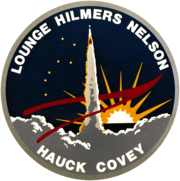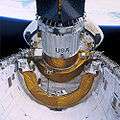STS-26
 STS-26 launches from Kennedy Space Center, 29 September 1988. | |||||
| Operator | NASA | ||||
|---|---|---|---|---|---|
| COSPAR ID | 1988-091A | ||||
| SATCAT № | 19547 | ||||
| Mission duration | 4 days, 1 hour, 11 seconds | ||||
| Distance travelled | 2,703,000 kilometers (1,680,000 mi) | ||||
| Orbits completed | 64 | ||||
| Spacecraft properties | |||||
| Spacecraft | Space Shuttle Discovery | ||||
| Launch mass | 115,487 kilograms (254,605 lb) | ||||
| Landing mass | 88,078 kilograms (194,179 lb) | ||||
| Payload mass | 21,082 kilograms (46,478 lb) | ||||
| Crew | |||||
| Crew size | 5 | ||||
| Members |
Frederick H. Hauck Richard O. Covey John M. Lounge David C. Hilmers George D. Nelson | ||||
| Start of mission | |||||
| Launch date | 29 September 1988, 15:37:00 UTC | ||||
| Launch site | Kennedy LC-39B | ||||
| End of mission | |||||
| Landing date | 3 October 1988, 16:37:11 UTC | ||||
| Landing site | Edwards Runway 17 | ||||
| Orbital parameters | |||||
| Reference system | Geocentric | ||||
| Regime | Low Earth | ||||
| Perigee | 301 kilometres (187 mi) | ||||
| Apogee | 306 kilometres (190 mi) | ||||
| Inclination | 28.5 degrees | ||||
| Period | 90.6 min | ||||
  Back row, L-R: Lounge, Hilmers, Nelson. Front row, L-R: Covey and Hauck.
| |||||
STS-26 was the 26th NASA Space Shuttle mission and the seventh flight of the orbiter Discovery. The mission launched from Kennedy Space Center, Florida, on 29 September 1988, and landed four days later on 3 October. STS-26 was declared the "Return to Flight" mission, being the first mission after the Space Shuttle Challenger disaster of 28 January 1986. It was the first mission since STS-9 to use the original STS numbering system, the first to have all its crew members wear pressure suits for launch and landing since STS-4, and the first mission with bailout capacity since STS-4. STS-26 was also the first all-veteran crew mission since Apollo 11, with all of its crew members having flown at least one prior mission.
Crew
| Position | Astronaut | |
|---|---|---|
| Commander | Frederick H. Hauck Third spaceflight | |
| Pilot | Richard O. Covey Second spaceflight | |
| Mission Specialist 1 | John M. Lounge Second spaceflight | |
| Mission Specialist 2 | David C. Hilmers Second spaceflight | |
| Mission Specialist 3 | George D. Nelson Third spaceflight | |
The crew roster for STS-26 was based on the original crew assignment for STS-61-F, which would have launched the Ulysses probe from Challenger in 1986. Ulysses was eventually launched on STS-41. Hauck, Lounge and Hilmers were all assigned to that flight, with Roy D. Bridges, Jr. as pilot. Bridges never flew again after the Challenger disaster, but would eventually become the Director of Langley Research Center.
Covey was the CAPCOM operator during the STS-51-L launch who uttered the words, "Challenger, go at throttle up", shortly after which the orbiter disintegrated. He also would have been the CAPCOM operator for the canceled STS-61-F mission during launch and landing.
Mission summary
Space Shuttle Discovery lifted off from Pad B, Launch Complex 39, Kennedy Space Center, at 11:37 am EDT on 29 September 1988, 975 days after the Challenger disaster. The launch was delayed by one hour and 38 minutes due to unseasonable and unusual light winds, and the need to replace fuses in the cooling systems of two crew members' flight suits. The suits were repaired, and a waiver was issued for the wind conditions after officials determined there was a sufficient safety margin for wind loads on the orbiter's wing leading edges. At T-1:30, it was proposed that the launch be delayed at T-0:31 due to a cabin air pressure issue. It was quickly determined that the cabin pressure had been increased slightly by the activation of the oxygen systems in the crew's flight suits, and the launch was conducted without further delay. The shuttle crew, all veteran astronauts, included Commander Frederick H. "Rick" Hauck, Pilot Richard O. Covey, and Mission Specialists John M. "Mike" Lounge, George D. "Pinky" Nelson and David C. Hilmers.
The primary payload for the STS-26 mission, a Tracking and Data Relay Satellite (TDRS), was successfully deployed, and 11 scheduled mid-deck scientific and technological experiments were carried out. The orbiter sustained only minor Thermal Protection System tile damage, and the redesigned post-Challenger solid rocket boosters showed no signs of leakage or overheating at any of the joints.
Two minor problems occurred during the flight. After ascent, the Flash Evaporator System for cooling the orbiter iced up and shut down, increasing the crew cabin temperature to approximately 87 °F (31 °C). The problem was resolved on Flight Day 4 and cooler temperatures resulted. A Ku-band antenna for communications was deployed on Flight Day 2, but it failed to respond properly and had to be stowed for the remainder of the mission.
During STS-26, Discovery became the first spacecraft to fly in space equipped with a VCU (Voice Control Unit), a computer capable of recognising and responding to human speech. The VCU was created by SCI Systems in Huntsville, Alabama, and was based on technology licensed from the Votan company. This speech recognition system controlled the cameras and monitors that were used by the crew to monitor the Canadarm mechanical arm mounted in the cargo bay. Because of the experimental nature of speech recognition at the time, this system was not used for any critical operations. Initial problems almost sidelined the tests when the voice templates that were created prior to liftoff were found to have less than 60% recognition for one crew member and less than 40% recognition for another. This problem was corrected by retraining the templates. It was retested and found to be operational with a recognition success rate of over 96%. It was concluded that weightless conditions caused a fundamental change in human speech, making the templates created prior to liftoff virtually useless.
Besides conducting the mission's various experiments, crew members practiced suiting up in new partial-pressure "launch-and-entry" flight suits, and also practiced the unstowing and attaching of the new crew escape system. On 2 October, the day before the mission ended, the five-man crew paid tribute to the seven crew members lost in the Challenger disaster.
Discovery landed on Runway 17, Edwards Air Force Base, California, at 12:37 pm EDT on 3 October 1988, after a mission duration of approximately 4 days and 1 hour. Capsule Communicator Blaine Hammond Jr. welcomed the crew, saying it was "a great ending to a new beginning."
Payloads and experiments

TDRS-C, which became TDRS-3 in orbit, and its attached Inertial Upper Stage (IUS), were deployed from Discovery's cargo bay six hours and 13 minutes into the flight. The first stage of the IUS placed TDRS-3 in a transfer orbit, and the second stage placed it in a geosynchronous orbit on 30 September. TDRS-3 moved into position over the Pacific Ocean south of Hawaii at 171 degrees west longitude. It joined TDRS-1 in tracking Earth-orbiting spacecraft; a sister satellite, TDRS-B, was lost in the Challenger accident. Also in the payload bay was the Orbiter Experiments Autonomous Supporting Instrumentation System (OASIS). OASIS recorded environmental data on the orbiter and the TDRS payload during various inflight phases.
All the mission's mid-deck experiments were deemed to have been performed successfully. However, there were some glitches with two of the five materials science experiments. In the Protein Crystal Growth experiment, two of the 11 proteins processed – including an enzyme believed to be key to the replication of AIDS – did not produce crystals suitable for analysis. Also, there were some equipment problems with the Automated Directional Solidification Furnace, an experiment to investigate the melting and solidification of various materials in zero-gravity.
The materials processing experiments included two Shuttle Student Involvement Projects, one on titanium grain formation and the other on controlling crystal growth with a membrane. Another materials science experiment, the Physical Vapor Transport of Organic Solids, was a joint project of NASA's Office of Commercial Programs and the 3M Company.
Three life sciences experiments were conducted, including one on the aggregration of red blood cells, intended to help determine if microgravity can play a beneficial role in clinical research and medical diagnostic tests. Two further experiments involved atmospheric sciences, while one was in communications research.
List of payloads

Primary payload
- NASA's Tracking and Data Relay Satellite-3 (TDRS-3), attached to an Inertial Upper Stage (IUS), became the second TDRS deployed. After deployment, the IUS propelled the satellite into a geosynchronous orbit.
Secondary payloads
- Physical Vapor Transport of Organic Solids (PVTOS)
- Protein Crystal Growth (PCG)
- Infrared Communications Flight Experiment (IRCFE)
- Aggregation of Red Blood Cells (ARC)
- Isoelectric Focusing Experiment (IFE)
- Mesoscale Lightning Experiment (MLE)
- Phase Partitioning Experiment (PPE)
- Earth-Limb Radiance Experiment (ELRAD)
- Automated Directional Solidification Furnace (ADSF)
- Two Shuttle Student Involvement Program (SSIP) experiments
- Voice Control Unit test and evaluation (VCU)
Damage to thermal protection
Discovery suffered severe damage to its thermal protection tiles in the underwing area. Post-flight analysis showed that the impact of a 12-inch long piece of cork insulation during ascent was the culprit. The origin of the debris was the forward field joint on the right-hand SRB. The damage was such that, during re-entry, the thermal protection tile eroded almost completely.[1]
Wake-up calls
NASA began its longstanding tradition of waking up astronauts with music during Apollo 15.[2] Each track is specially chosen, often by the astronauts' families, and usually has a special meaning to an individual member of the crew, or is applicable to their daily activities.[2]
| Flight Day | Song | Artist/Composer |
|---|---|---|
| Day 2 | "Gooooooood Morning Discovery!!" | Robin Williams |
| Day 3 | "I Get Around" parody | Mike Cahill |
| Day 4 | "Fun, Fun, Fun..." parody | Mike Cahill |
Gallery
 Discovery launches from Kennedy Space Center.
Discovery launches from Kennedy Space Center. A view of the shuttle's cargo bay.
A view of the shuttle's cargo bay. The tilt table in its deploy position.
The tilt table in its deploy position. The release of the TDRS.
The release of the TDRS.- The Hawaiian Islands imaged from orbit.
- Chad imaged from orbit.
- Jebel Marra, Sudan, imaged from orbit.
 Discovery landing at the end of STS-26.
Discovery landing at the end of STS-26.
See also
References
![]() This article incorporates public domain material from websites or documents of the National Aeronautics and Space Administration.
This article incorporates public domain material from websites or documents of the National Aeronautics and Space Administration.
- ↑ Young, ch.22
- 1 2 Fries, Colin (20 April 2010). "Chronology of Wakeup Calls" (PDF). NASA. Retrieved 24 May 2010.
Bibliography
Young, John W. (16 September 2012). Forever Young: A Life of Adventure in Air and Space. University Press of Florida. p. 432. ISBN 978-0813042091.